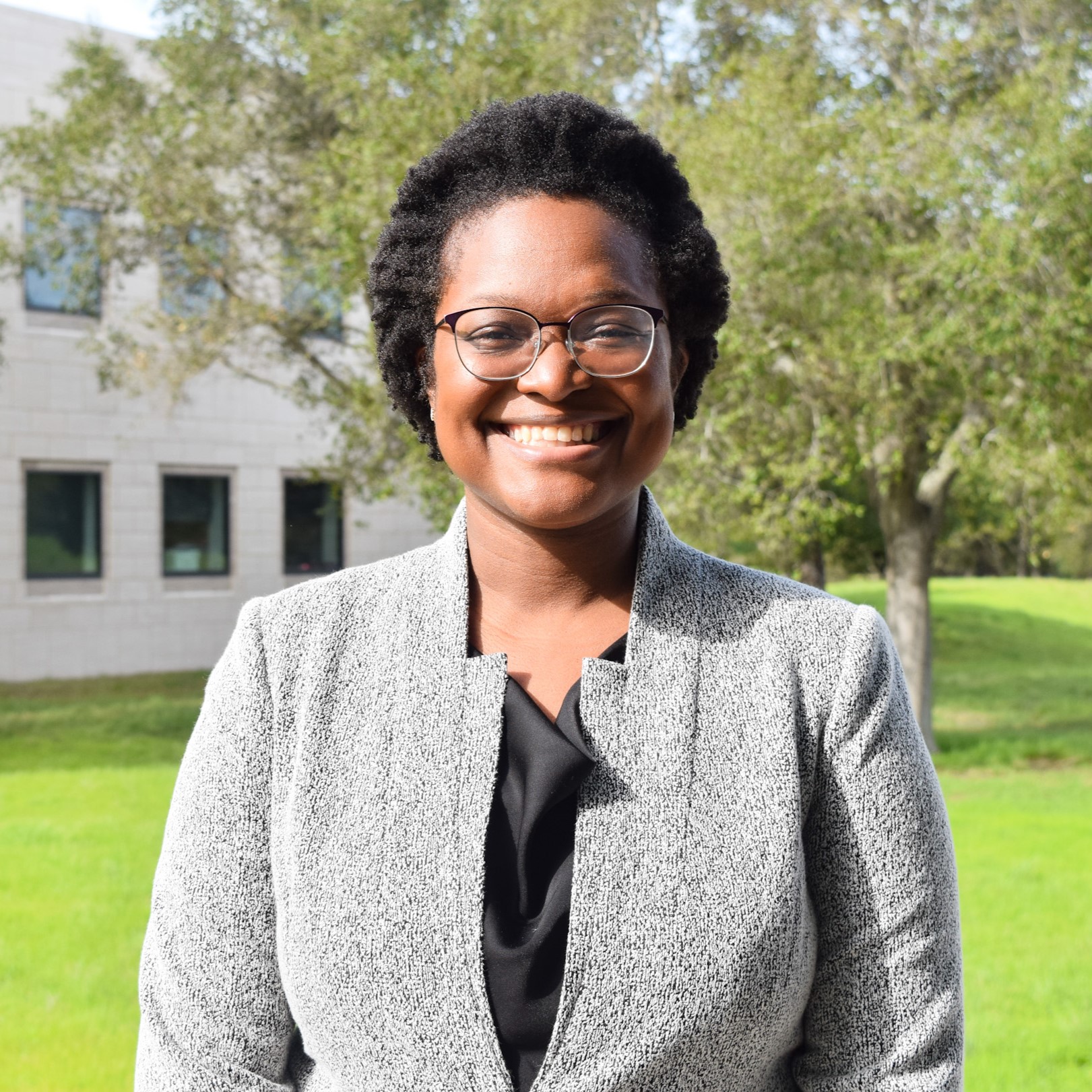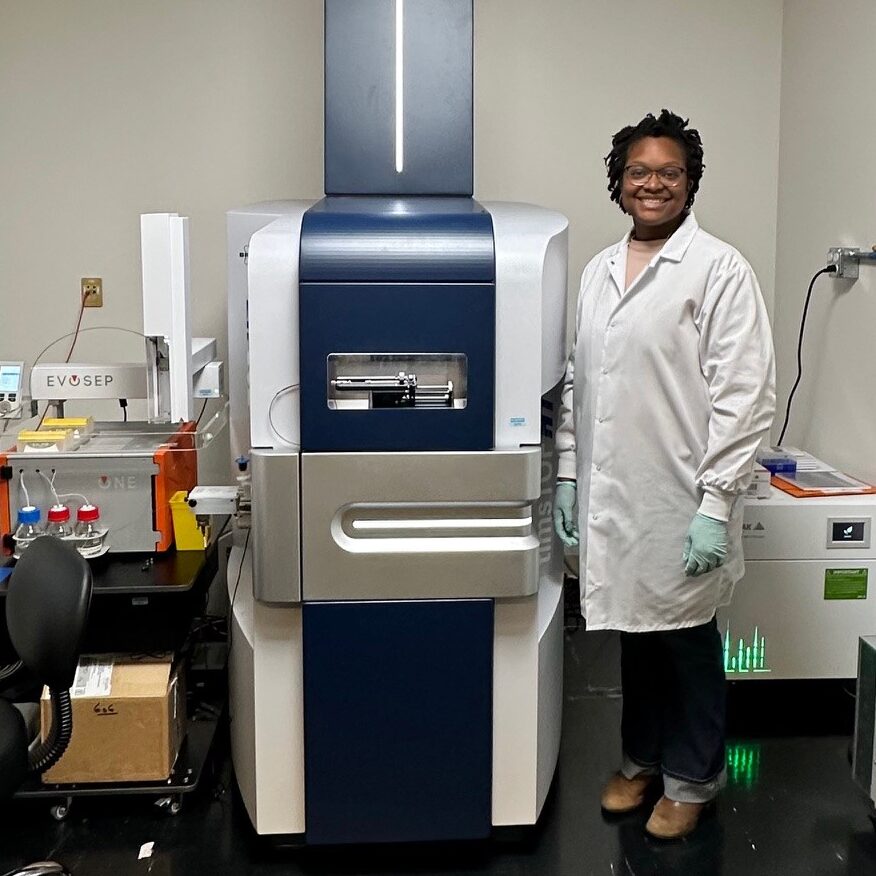by Buck Institute
March 13, 2024 . BLOG
Meet Buck Scientist Christina King, PhD
A “Rising Star” makes her mark in the Buck’s Mass Spectrometry Center and Proteomics Core
 Christina King, the associate director of the Buck’s Mass Spectrometry Center and Proteomics Core, woke up to some text messages on a Saturday morning earlier this year from friends congratulating her for “making the list.” She was named a “2024 Rising Star” by the Journal of Proteome Research as a young researcher who has “already demonstrated incredible originality and promise for the future of proteomics and metabolomics.” It’s significant recognition in an important field of science that can seem daunting for the lay public to understand. So, we asked the native Texan to explain herself:
Christina King, the associate director of the Buck’s Mass Spectrometry Center and Proteomics Core, woke up to some text messages on a Saturday morning earlier this year from friends congratulating her for “making the list.” She was named a “2024 Rising Star” by the Journal of Proteome Research as a young researcher who has “already demonstrated incredible originality and promise for the future of proteomics and metabolomics.” It’s significant recognition in an important field of science that can seem daunting for the lay public to understand. So, we asked the native Texan to explain herself:
How do you describe your work to non-scientific friends and family?
If I’m talking to someone who does not have a scientific background, I’ll just tell them that I’m interested in studying how proteins change in various conditions related to aging. Once I say things like, ‘Oh, I’ve studied Alzheimer’s,’ or more recently, reproductive aging, people are really interested because they can relate for different reasons. I also just tell people I use a lot of cool instrumentation to study what’s going on with someone who may be younger versus someone who’s older. I’m such an instrument geek!
What brought you to the Buck?
 I was finishing up my postdoc training at Vanderbilt University where I was applying proteomic techniques to study the relationship between hypertension and the onset of Alzheimer’s disease in African Americans. I was looking for a science position that would allow me to utilize my proteomic expertise in studies involving aging or neurodegenerative disease. Birgit Schilling, who is a professor at the Buck and directs the Mass Spectrometry Center and Proteomics Core, was looking for a staff scientist, so I went ahead and applied for the position. After meeting her and the Schilling team, I decided this position would be a great opportunity, so I accepted the position. I arrived in December 2020, in the midst of the Covid lockdown, which was a pretty strange time to start a job that is normally so collaborative in nature.
I was finishing up my postdoc training at Vanderbilt University where I was applying proteomic techniques to study the relationship between hypertension and the onset of Alzheimer’s disease in African Americans. I was looking for a science position that would allow me to utilize my proteomic expertise in studies involving aging or neurodegenerative disease. Birgit Schilling, who is a professor at the Buck and directs the Mass Spectrometry Center and Proteomics Core, was looking for a staff scientist, so I went ahead and applied for the position. After meeting her and the Schilling team, I decided this position would be a great opportunity, so I accepted the position. I arrived in December 2020, in the midst of the Covid lockdown, which was a pretty strange time to start a job that is normally so collaborative in nature.
What do you like about the Buck?
I was ecstatic when we were able to move away from that lockdown stage and have in-person events and meetings again, because I was able to see the different communities for trainees and all the collaborative projects underway. I think the Buck is an electrifying place, where there’s lots of opportunities to meet people. And if you want to grow, there’s opportunities for you move forward in that regard. While I got a glimpse of that during the brunt of COVID, once we were able to open up, I was able to see how well people work together. I was able to see how well the projects integrate with each other, and how having this interdisciplinary focus really enriches the work. Because you can have different points of view and then you also have different expertise that really elevates a lot of projects. I’ve had some really great opportunities here. I think the Buck is a great place, and I see why we’re soaring.
Is there a particular project that you’re most excited by? What is most exciting about your work overall?
I’ve really taken an interest in the work that we’ve been doing in our reproductive aging program. I’ve had the opportunity to work on a couple of projects that have been looking at reproductive aging in a physiological model of aging. That’s in a mouse model. We’ve also been looking at racial disparities in the post-menopausal human ovary. I love working with the various instruments in the Core. It’s really exciting to get fresh data and then dive into the weeds to see what it all means.
Since we collaborate with so many labs at the Buck, I have had the opportunity to gain a deeper understanding of the types of aging and aging-related problems being investigated here.
Were you always interested in science? Was there an a-ha moment when you knew what you wanted to do?
I feel like I was more of an arts kid, actually. I thought that I would be a teacher when I was younger. I was a choir kid, so I sang all the way through high school. I was also a Girl Scout, so I can pretty much do any craft you can think of. I was very outdoorsy for someone growing up in Houston. We would go camping a lot. I liked science, but it didn’t grab my attention. Unfortunately, a lot of girls were not encouraged to engage in STEM-related activities. That’s changing though. Thankfully my parents let me discover myself. They never tried to push me in one direction or the other. So, I think I liked science, but if I think about it, I’m more artsy, actually.
Interesting. But you got your bachelor’s degree in science, right?
Exactly. Originally, I was going to study biology, and I was going to go the teaching route. Then for a while I was considering medical school and that’s when I became interested in chemistry. Organic chemistry was a game changer for me because I really liked the distillation experiments, and we distilled some type of esters that essentially made bubble gum. I thought that was really neat. And so that is why I switched to chemistry which gave me a lot of career opportunities.
Was there any particular scientist who inspired you or was important to your career trajectory?
I’ve had opportunities to meet female scientists who work in mass spectrometry and it’s really remarkable to hear about their scientific journeys. I would be remiss not to acknowledge my PhD advisor, Dr. Renã Robinson. She’s been an excellent example of what it’s like to be a black woman in STEM. She allowed me to really focus on my science and avoid some of the issues that some black graduate students experience. I was fortunate that she shielded me from those things.
Some people experience microaggressions, macroaggressions, but I never had to worry about someone saying something like, ‘Oh, maybe you shouldn’t wear your hair like this (e.g., braids or an afro) at a conference.’ Or be concerned with people harping on how I speak or how I present myself. I really was allowed to be a scientist, and I think it’s because Dr. Robinson really protected me.
What drew me to her lab was that she was working on aging. And I was like, ‘Well, I think older people are really wise, and I have a lot of respect for them, and I want them to live the best they can.’ So, I think I had more of an attitude like, ‘Oh, these projects will help the older population. And she’s using mass spectrometry as a tool to study that.’ So those projects are what really got me in the door to this exciting field.
That’s wonderful. So, what do you do when you’re not doing science?
I rest. Rest is so important. That’s what I’ve learned. But I’ve actually picked up climbing. I’ve been doing this for a few months now.
So you go to the gym, and you climb walls?
Yes. I boulder. What I really like about bouldering is that you have to use critical thinking skills to identify which route you should use to reach the top of the wall. When you’re on the wall, you can’t think about other things or else you’ll fall. Right? So, it’s really helped me in terms of just being really intentional about what steps I want to take.

SHARE